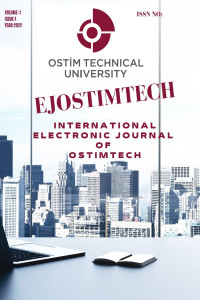Öz
Kaynakça
- Anderberg, M. (1973). Cluster Analysis for Applications Academic Press. New York, 553-55.
- Bartelse, J., & Vught, F. (2007). Institutional profiles: Towards a typology of higher education institutions. IAU Horizons, 13(2-3),9-11.
- Günay, D., & Günay, A. (2011). 1933’den günümüz Türk yükseköğretiminde niceliksel gelişmeler. Yükseköğretim ve Bilim Dergisi, 1(1),1-22.
- Johnson, R. (2002). Applied Multivariate Statistical Analysis.
- Küçükcan, T., & Gür, B. (2009). Türkiye’de yükseköğretim: Karşılaştırmalı bir analiz. Ankara: SETA Yayınları.
- Ma, Z., JN, R., & Tavares, J. (2009). A Review on the current segmentation algorithms. In IMACAPP, 135-40.
- Raponi, V., Martella, F., & Maruotti, A. (2016). A biclustering approach to university performances: An Italian case study. Journal of Applied Statistics, 43(1), 31-45.
- Shin, J. (2009). Classifying higher education institutions in Korea: A performance-based approach. Higher Education, 57(2), 247-266.
- Tosun, H. (2015). Devlet üniversiteleri: Performans değerlendirme finansman modeli ve yeniden yapılanma. Ankara: Uzman Matbaacılık.
CLASSIFICATION OF FOUNDATION UNIVERSITIES BY CLUSTER ANALYSIS ACCORDING TO ACADEMIC, FINANCIAL AND ADMINISTRATIVE INDICATORS
Öz
The aim of the study is to examine Turkey's 76 foundation universities according to academic, financial and administrative indicators with cluster analysis and classify them within the framework of selected variables. In the study, variables accepted as academic, financial and administrative indicators were clustered using Ward's method and k-mean method. The most up-to-date data published on the Higher Education Institution (YÖK) website was used as the data source. 76 universities were grouped into six clusters according to the hierarchical clustering analysis using 13 academic, financial and administrative indicators. Then the k-means method was applied. The efficiency of the academic, financial and administrative variables of the universities in the formed clusters was determined by the results of ANOVA. While performing hierarchical clustering methods, standardization process was applied to the data. At the same time, it was determined which method would be applied depending on the observation data, variable data type and number. As a result of this study, in which two clustering methods were studied, different clustering structures were obtained for both methods.
Anahtar Kelimeler
Cluster Analysis Foundation University Ward’s Method k-Means Method
Kaynakça
- Anderberg, M. (1973). Cluster Analysis for Applications Academic Press. New York, 553-55.
- Bartelse, J., & Vught, F. (2007). Institutional profiles: Towards a typology of higher education institutions. IAU Horizons, 13(2-3),9-11.
- Günay, D., & Günay, A. (2011). 1933’den günümüz Türk yükseköğretiminde niceliksel gelişmeler. Yükseköğretim ve Bilim Dergisi, 1(1),1-22.
- Johnson, R. (2002). Applied Multivariate Statistical Analysis.
- Küçükcan, T., & Gür, B. (2009). Türkiye’de yükseköğretim: Karşılaştırmalı bir analiz. Ankara: SETA Yayınları.
- Ma, Z., JN, R., & Tavares, J. (2009). A Review on the current segmentation algorithms. In IMACAPP, 135-40.
- Raponi, V., Martella, F., & Maruotti, A. (2016). A biclustering approach to university performances: An Italian case study. Journal of Applied Statistics, 43(1), 31-45.
- Shin, J. (2009). Classifying higher education institutions in Korea: A performance-based approach. Higher Education, 57(2), 247-266.
- Tosun, H. (2015). Devlet üniversiteleri: Performans değerlendirme finansman modeli ve yeniden yapılanma. Ankara: Uzman Matbaacılık.
Ayrıntılar
| Birincil Dil | İngilizce |
|---|---|
| Bölüm | Research Articles |
| Yazarlar | |
| Yayımlanma Tarihi | 28 Kasım 2022 |
| Gönderilme Tarihi | 24 Eylül 2022 |
| Yayımlandığı Sayı | Yıl 2022 Cilt: 1 Sayı: 1 |


